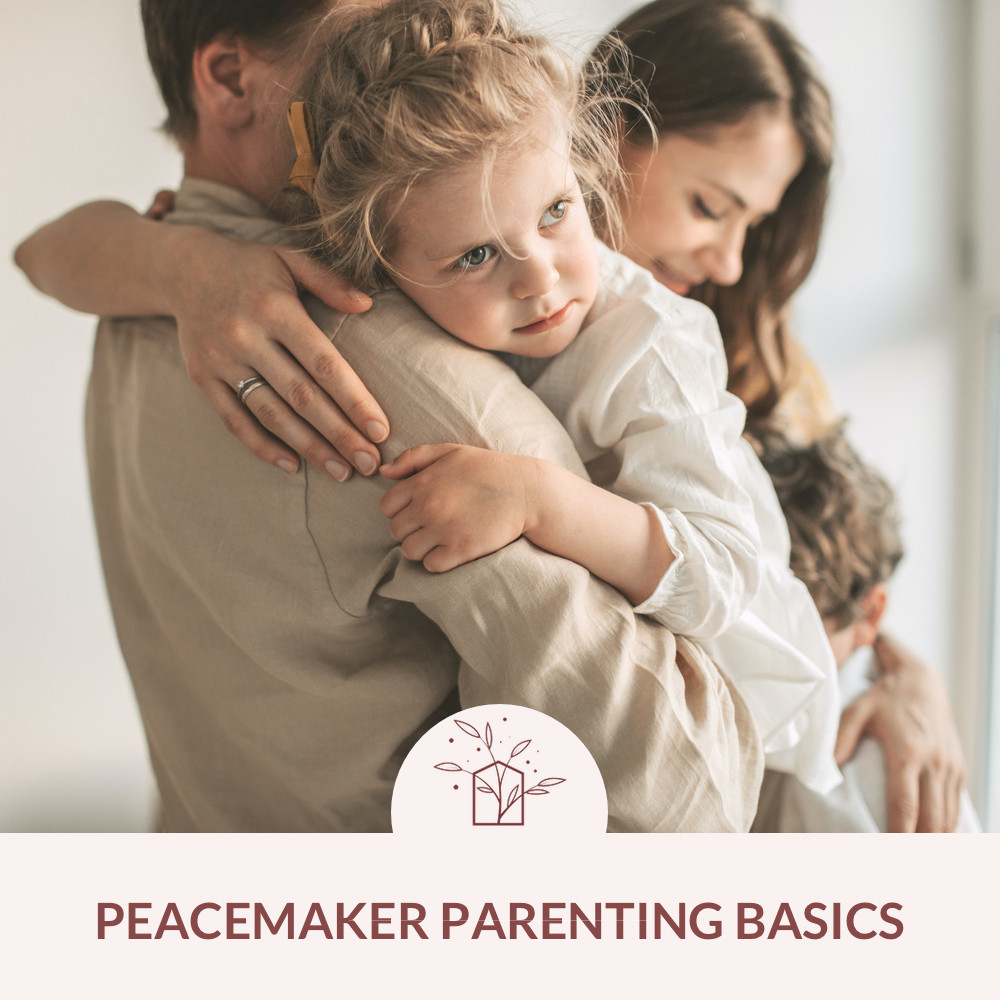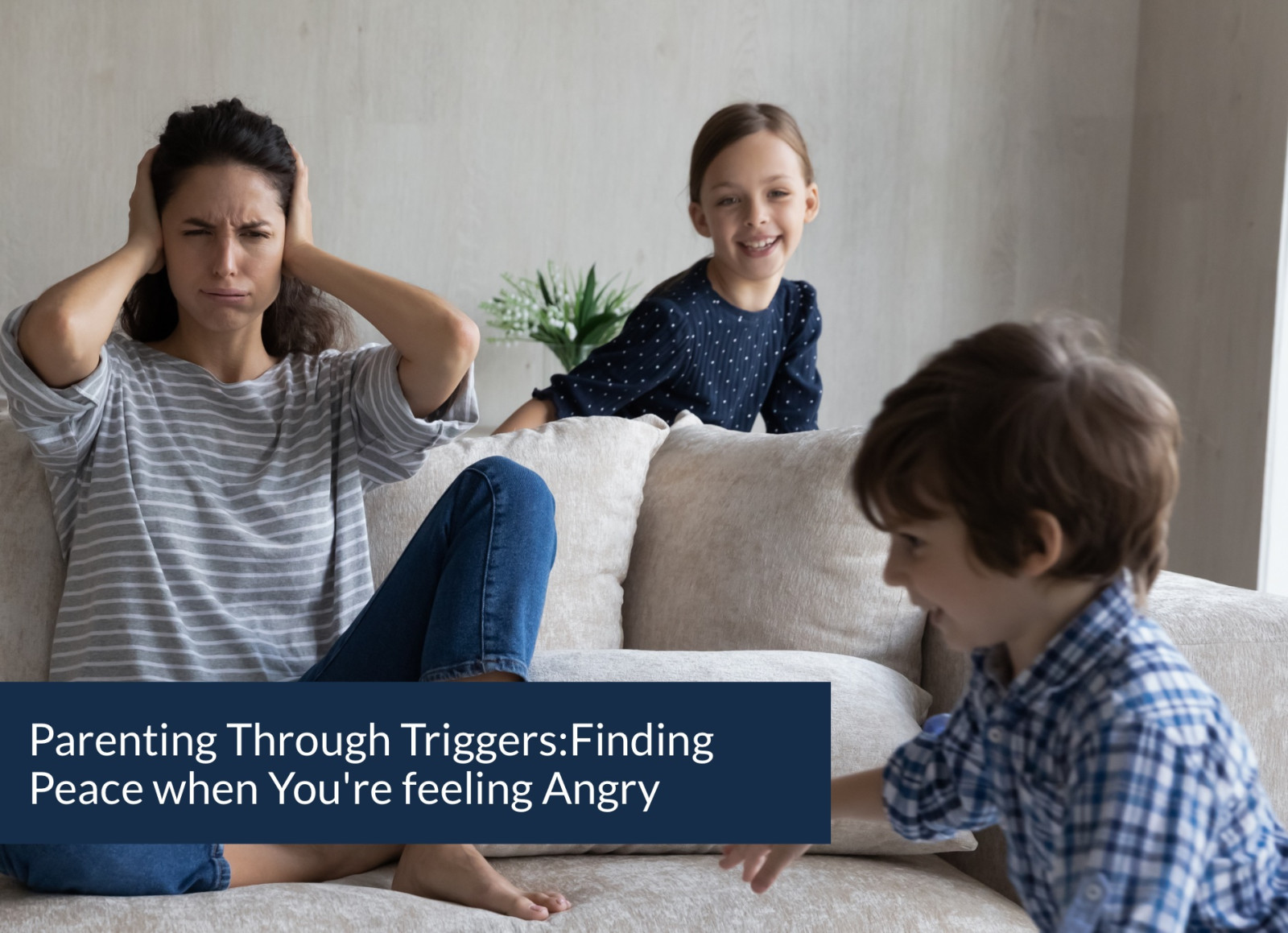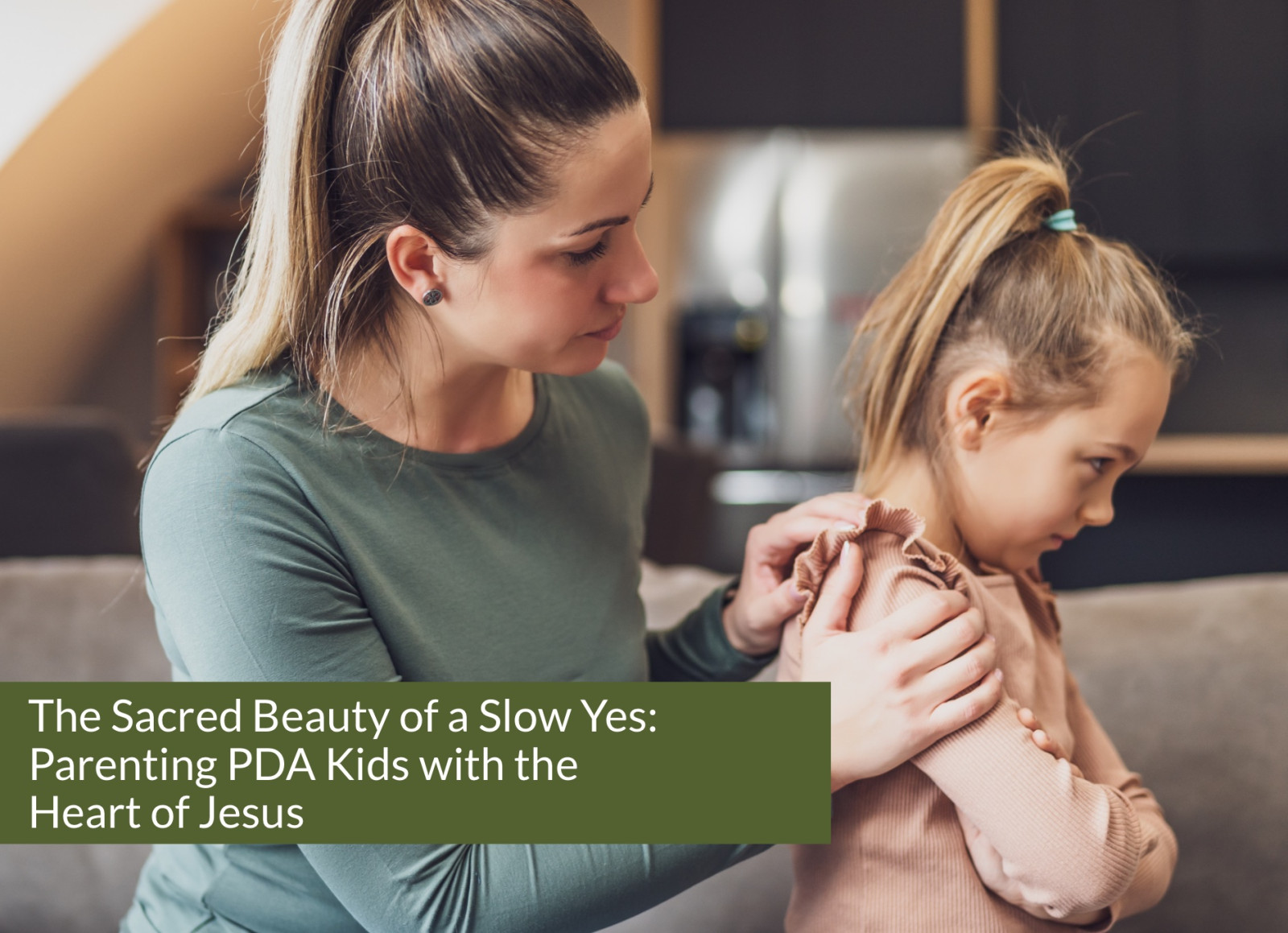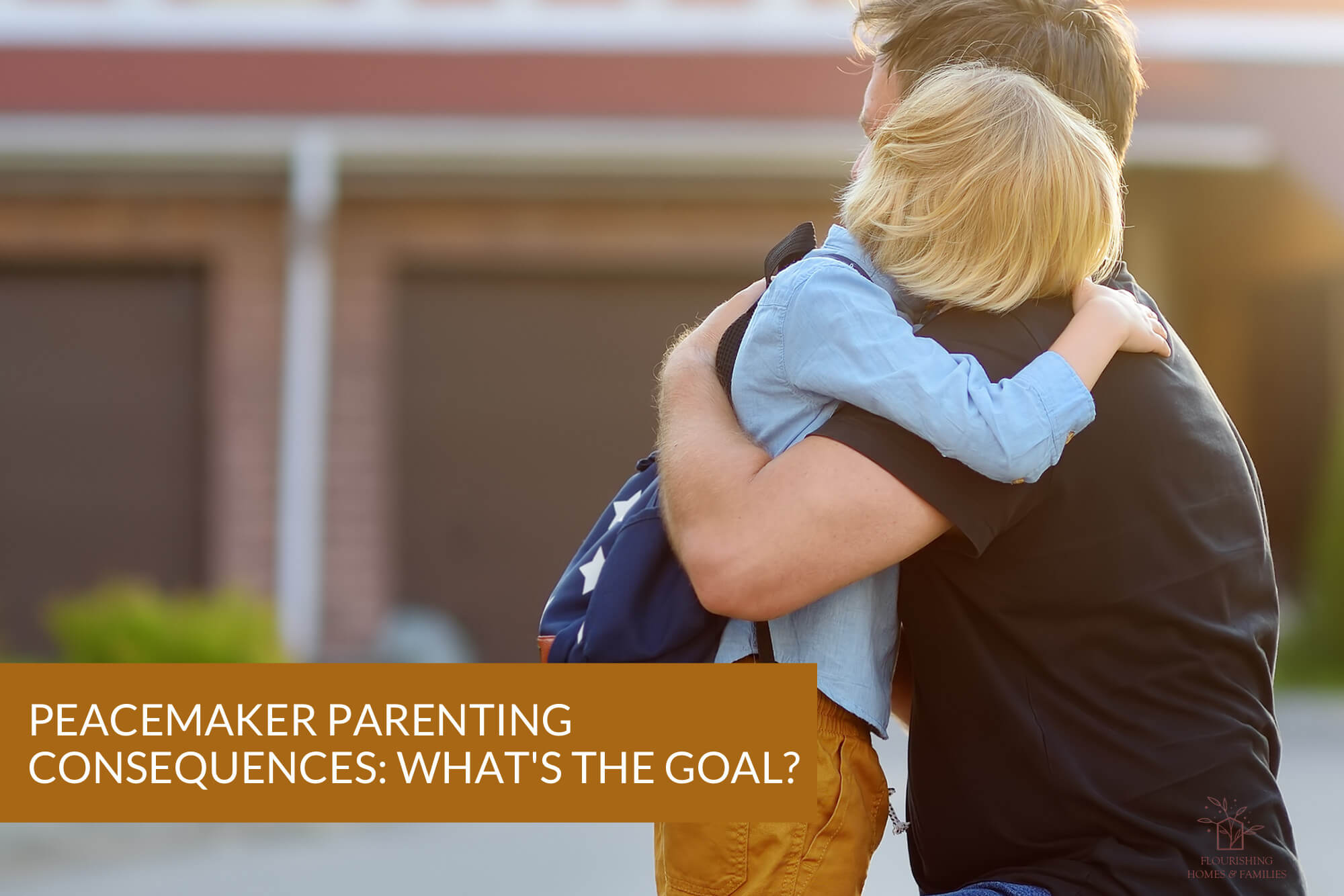
WHAT IS PEACEMAKER PARENTING?
Peacemaker Parenting is a model for parenting that is rooted in the teachings of Jesus and backed by modern neuroscience. It equips parents and caregivers to develop deeply connected and secure relationships with their children, and empowers them with tools and strategies to lead and guide their families with Jesus, and His grace, at the center of their homes and families. You can learn more about Peacemaker Parenting here.
WHAT ARE THE PEACEMAKING GOALS OF CONSEQUENCES?
Let's lay the foundation for consequences in Peacemaker Parenting. In the old parenting paradigm, you may have thought of consequences as a way to "teach them a lesson", make them feel as bad as they made someone else feel, or as a punishment for bad behavior. We sure did! We viewed consequences as a way to correct sin right here, right now, so that they'll never do it again! Right? Wrong.
Negative consequences can be highly effective at teaching children what not to do. They use a child’s fear/survival response in the brain to make associations between poor choices/bad behavior and negative stimuli. The problem is: the child isn’t actually learning anything. In the brain, it’s simply behavior adaptation for survival. And the skills, wisdom, perspective, critical thinking, emotional regulation, and alternative actions aren’t being developed or taught with negative consequences.
In Peacemaker Parenting, consequences serve a different purpose altogether. They are not intended to make a child suffer, in other words, they're not about retribution. And they’re not even reactionary. As much as we're able, consequences are responsive and proactive:
The three primary goals of consequences are:
When we shift our view of consequences from punitive to edifying, it completely changes how we interact with our children when consequences are needed.
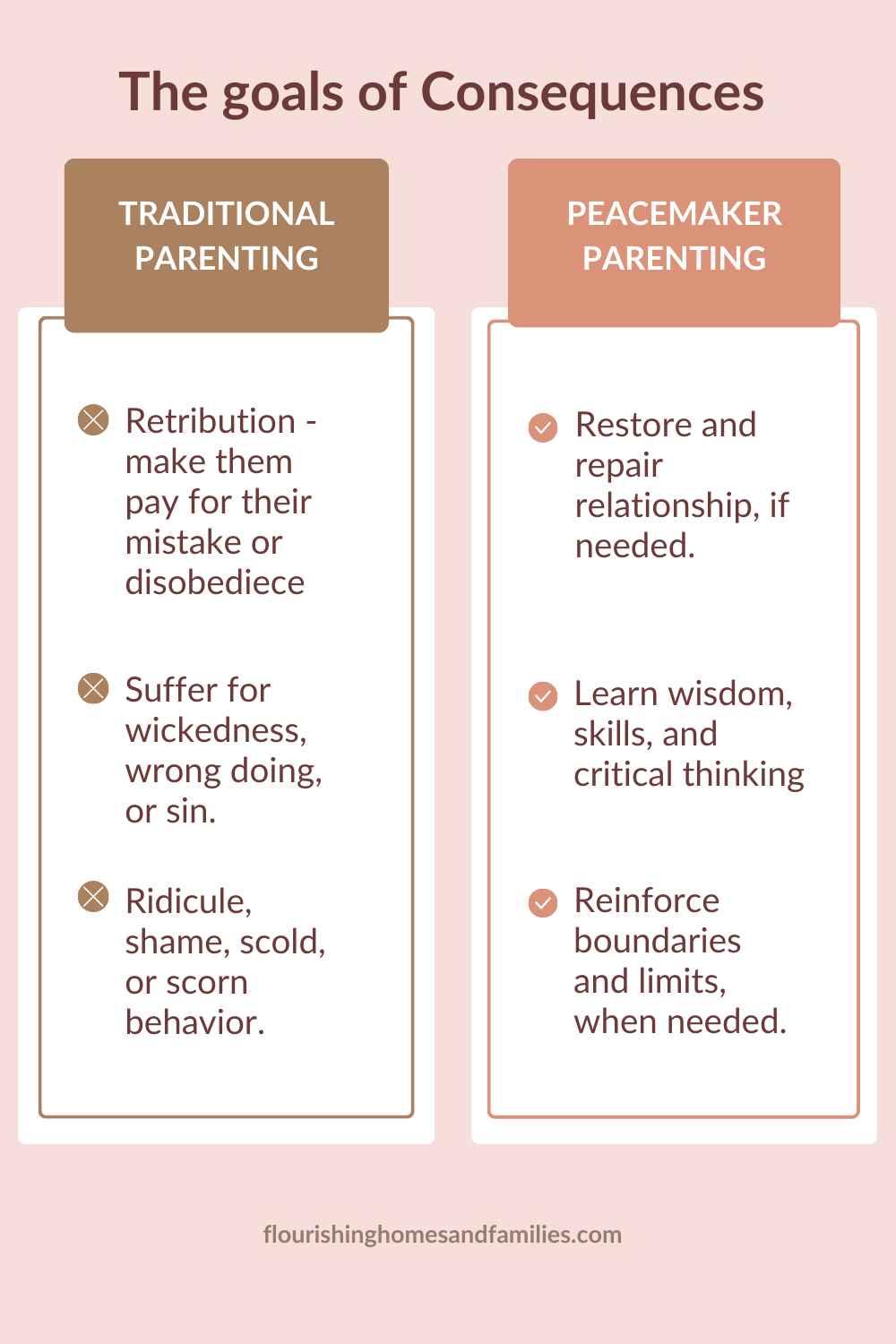
Lastly, consequences are primarily about equipping for the future, not about punishing the past. You can learn more about future-facing consequences here.
YOU MIGHT ALSO LIKE:

Holidays are a pretty special time of year. They're special for so many reasons, and young children don't always understand those reasons. What they do understand is that things are quite out of the ordinary, and that can cause feelings of anxiousness, excitement, apprehension, and curiosity.
Setting our little ones up for a great holiday experience means that we need to prepare them for what to expect. You can use the acronym P.R.E.P to help you know how to pepare your child for the next several weeks of extra excitement.
P = PREPARE
Leading up to the holiday season, prepare your child for what the next several weeks will look like. You may want to prepare them for:
- Schedules and routines that fall outside you family's normal. “We will be visiting Grandma and Grandpa and their supper time is usually a little bit later than ours. That’s okay, because we will have snacks if you get hungry before supper is ready.”
- Changes to how places look. (This is especially important for potential sensory overload.) “When we go to church tomorrow things might look a little different. There will probably be extra flowers and maybe a Christmas tree, and I just want you to know that it will look different.” or “When we go shopping there will be someone ringing a bell at the front doors. They’re collecting money for people who don’t have enough. The bell might seem really loud to you, it’s okay to cover your ears.”
- Family members and friends they aren’t very familiar with. “You’re going to get to see Aunt Brenda. Do you remember her? No? She loves you very much, and it’s okay if you’re not ready to talk to her or hug her right away. Sometimes it takes a little while to warm up to people. I will be with you.”
- New food. “Every year Grammy makes Swedish Meatballs for Christmas Eve dinner. We’ll make a plate for you and you’ll have a no-thank you bowl you can use. It’s okay if there's something you don't like.”
- Out of the ordinary events, such as Christmas cantatas at church, Christmas parties, and special family gatherings. "Tonight we are going to a candle light service at church. It will be darker and quieter than usual. We will take a fidget toy for you to play with quietly."
- Schedules for holiday celebrations. “After breakfast we will go to Grandma’s house. Once everyone gets there we will open presents, then we’ll eat lunch. After lunch you’ll have play time and then quiet time. If we need to come home for quiet time we can do that too.”
R =ROLE-PLAY
Use toys, pretend play, and role reversal to help prepare your child for big events and specific situations. Play is a great way to coach them on how to respond in tricky situations, and it allows them to practice so they can build skills and confidence. Some specific situations you may want to practice:
- Not liking holiday food
- Not wanting to give hugs or say goodbye
- If someone wants to play with their toys
- If they need alone time or quiet time
- Getting bored in the car
- Sitting through a play or pageant
- Connecting with long distance family virtually
- Taking turns
E =EXPLAIN
Using age-appropriate words and ideas, explain important traditions, family values, and details of how you celebrate. You may want to consider explaining:
- Why your family celebrates specific holidays
- Why family time or Friendsgiving is important to you
- Why you drive a long ways to see family even though car rides are boring
- Where important traditions came from
- Why you don't buy Christmas gifts for your child while they're shopping with you
- Why sitting through a quiet or different church service is important to your family
- Why you celebrate Jesus' birthday
These are conversations that are best had during moments of connection, and they should come across as normal conversation rather than “teaching” or lecturing. You may find yourself explaining these naturally in response to a tender and curious "Why?"
P =PLAN
Preparing your child for your "behavior response plan" helps them know that you will be steady and supportive even when they struggle. The good news is that this can reduce power struggles, and it reinforces attachment and connection. And bonus: there's something about knowing that your child knows what to expect from us that helps hold us accountable!
Here are a few ideas + scripts:
“If you get overwhelmed when everyone is opening presents, you and I can go to our snuggle spot to calm down, then go back to the presents when you’re ready. All of your presents will be there, and we all want you to be able to enjoy opening them.”
“If you don’t like Grandma’s food that’s totally okay. Everyone has different taste buds. We will take chicken nuggets and apples that you can eat if you don’t like any of the food you try.”
“Sometimes it is hard to leave Grandma's house. If it’s especially hard on Christmas day, you can try not saying goodbye.Goodbyes are hard! I will just carry you to the car.”
You don’t have to share your plan for every single scenario (and let’s face it, there’s a good chance your kiddo will present you with a situation you don't have a plan for!). Sharing your plan for you child ahead of time communicates compassion and empathy by normalizing strong emotions during high-stress situations and it builds confidence for you as a parent.
- Let them know the plan and what the day will look like. "Tomorrow is Thanksgiving Day! We're going to wake up and eat a special breakfast, then we're going to go meet Grandma and Grandpa at the park and have a picnic. You'll get to play and I bet Grandpa is going to want to swing you. After lunch we'll come home for quiet time, and then before bedtime we're going to go look at Christmas lights!"
- Empathize ahead of time. "You're going to see some family members we don't see very often. It's okay if you don't know what to say or if you don't feel like talking to them. Lots of people feel nervous to talk to new people."
- Remember to use visual clues, not time-bound clues throughout the day. "We're going to eat cheesecake and then we're going to pick up toys, say goodbye, and go home."
- Invite them to help plan and collaborate. "We're going to have a family Zoom call after lunch! Where do you think we should sit for our call? What toys or books do you want to share with Auntie Mac?"
- Make all plans equal. Have multiple plans for a peaceful, successful day, keep your expectations age-appropriate, be flexible, and know that if your little one winds up not getting a nap, it will still work out.
- Keep perspective. Holidays are wonderful, but stressful! There's a good chance even the adults in your family don't fully know what to expect! Cultivate compassion, empathy, and understanding for your little one, yourself, and your family.
Helpful Tool: Visual Routine for Kids
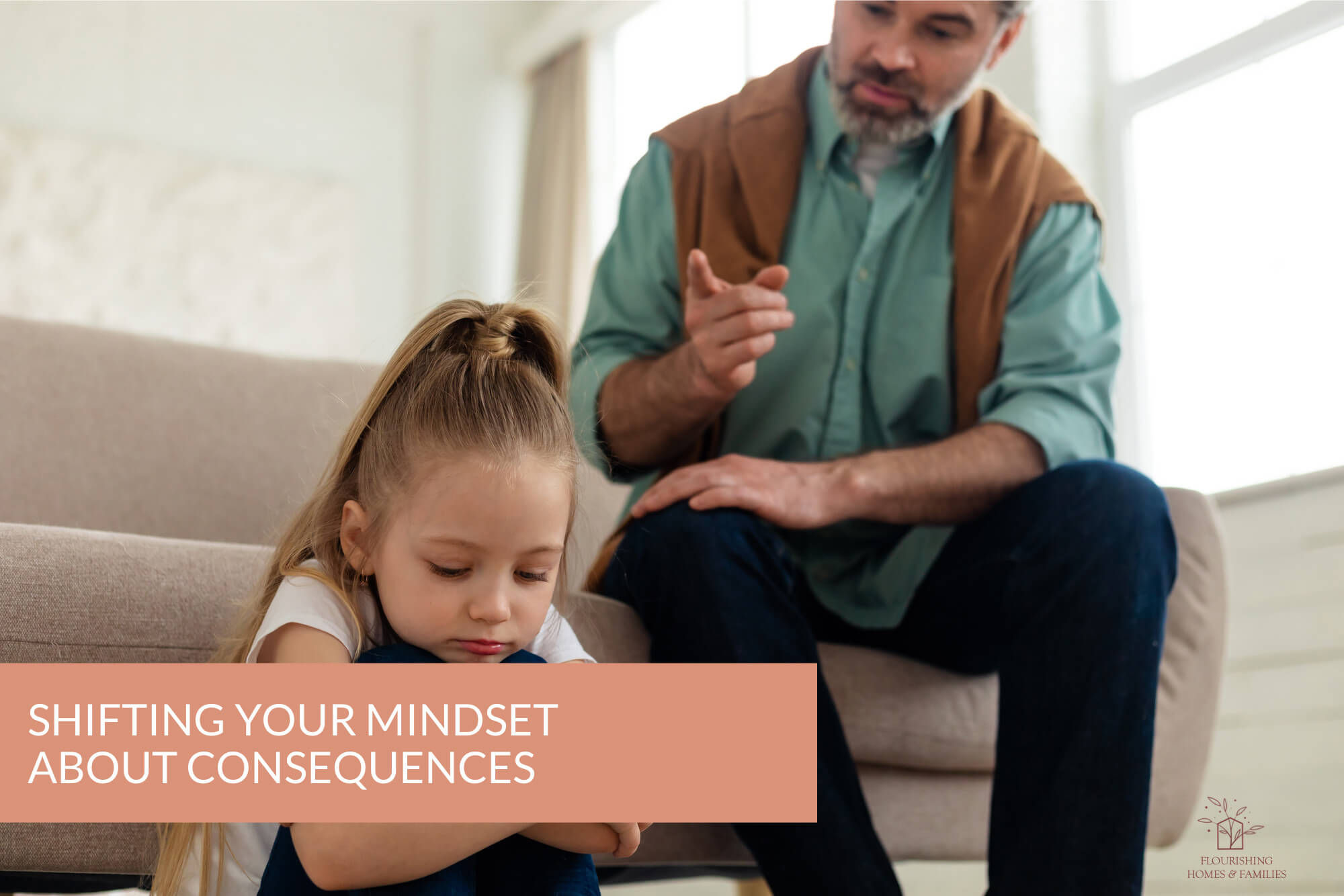
Brooke, one of the moms in The Mentorship, shared this story with us recently that perfectly illustrates the Peacemaker Parenting approach to consequences:
"That last time we were at my mom's house, Eli (4) started playing with a ball inside. He wasn't being particularly naughty or disruptive with it, so we adults just sort of kept talking and didn't pay that much attention. Before I knew it, Eli had thrown the ball at just the right angle and knocked a picture off the credenza, breaking the glass. In the past I would have been very stern with him, scolded him for being naught, put him in time-out, and put the ball away. This time I tried to focus on future-facing consequences. Because there was glass involved I didn't make him help me clean it up. But we did talk to his Grandma and together we decided that Eli and I would go to the craft store and replace the glass in the frame. We also defined new expectations that balls are only for the back patio or back yard at Grandma's house. My mom is going to get an all-weather basket or tote to keep outside toys in for the future."
First, let us make this disclaimer perfectly clear, because sometimes it is misunderstood or misconstrued: Peacemaker Parenting does not avoid all consequences, and we personally don't believe consequences should never be used.
That being said, when a parent's mindset is heavily weighted towards consequences, they are more likely to fail at helping children learn the skills and tools, and gain the maturity needed to do better next time. Focusing on consequences is a backward-facing approach. Focusing on empowering is a forward-facing approach. This is why, in Peacemaker Parenting, we do not rely on consequences to hold boundaries and limits or to manage and control behavior.
HELP VS. HURT
Nearly every choice and behavior has a natural consequence or outcome, and those natural consequences can sometimes be the best teachers. When we settle into a consequence-heavy mindset, it is easy to unintentionally hurt our children with the consequence (which breaks trust and connection and inhibits their ability to learn to do better), rather than helping them know what or how to do differently next time. Rather than looking forward to what can be done differently next time, our child focuses on the imposed consequence (which can very easily just be a "punishment" delivered more gently).
Max Bledsoe, father of Drew Bledsoe and author of Parenting with Dignity explains why this can be counter productive:
"When a parent resorts to punishment, parent and child pay attention to the punishment, its fairness, and whether it has been enforced or followed. The child stops thinking about the decision process in his mind that brought about the negative consequences—and doesn’t think at all about what he might do differently."
EMPOWERING VS. IMPOSING
It isn't that there is never a need for logical consequences - there certainly are! But removing a child from a harmful situation or taking away something to keep it safe merely fixes the problem in the moment. Our children need to be patiently coached, guided, taught, and empowered with how to handle the same situation next time. Empowering them with emotional regulation tools, scripts for respectful conflict, and what or how to do better next time equips them for the future rather than punishing them for the past.
This is where future-facing consequences can be so life-giving.
FUTURE VS. PAST
Future-focused discipline allows us to evaluate our children as whole beings, taking into account their physical, emotional, and sensory needs, their personalities, and their development. That enables us as parents to create a robust and wholistic approach to empowering them for the future. This can take many forms, from practicing impulse control through classic childhood games like Simon Says and Red Light, Green Light, (which, admittedly may not feel very "discipline-y", but it is important to build and strengthen a child's impulse control "muscle" before placing an expectation on them that is rooted in controlling impulses and urges) to brainstorming a code word or private prompt for you to use when they need a gentle reminder to speak with respect and honor.
The summer our boys were 7 and 8 they struggled with sibling conflict more than what we thought was typical. It felt like every little thing turned into an explosive argument. By that time we'd spent a few years teaching them healthy conflict resolution, but all of it seemed to have gone out the window.
We could have punished them for fighting, or used a reward system to motivate them to focus on being kind to each other. Instead, we invited them to write and illustrate their own P.E.A.C.E. Plan. They spent a couple of hours one afternoon creating a conflict resolution guide customized to their personalities and needs, that they were then able to use any time they had disagreements or problems that needed intentional peace infused into the situation. This is a future-facing consequence - it empowers them with a tangible tool to help them in the future, rather than using negative consequences to try to deter their fighting.
Want to learn more? Check out our upcoming workshop: Discipline without Spanking:
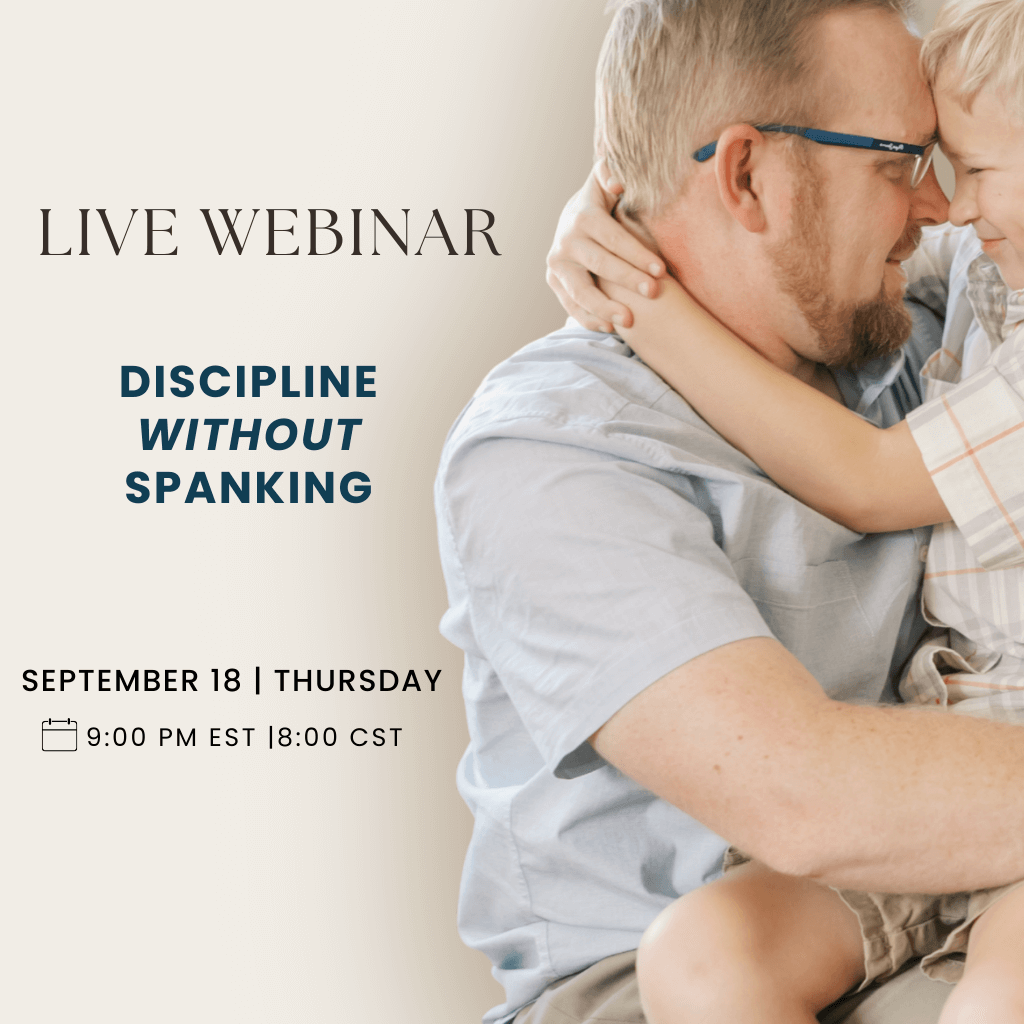
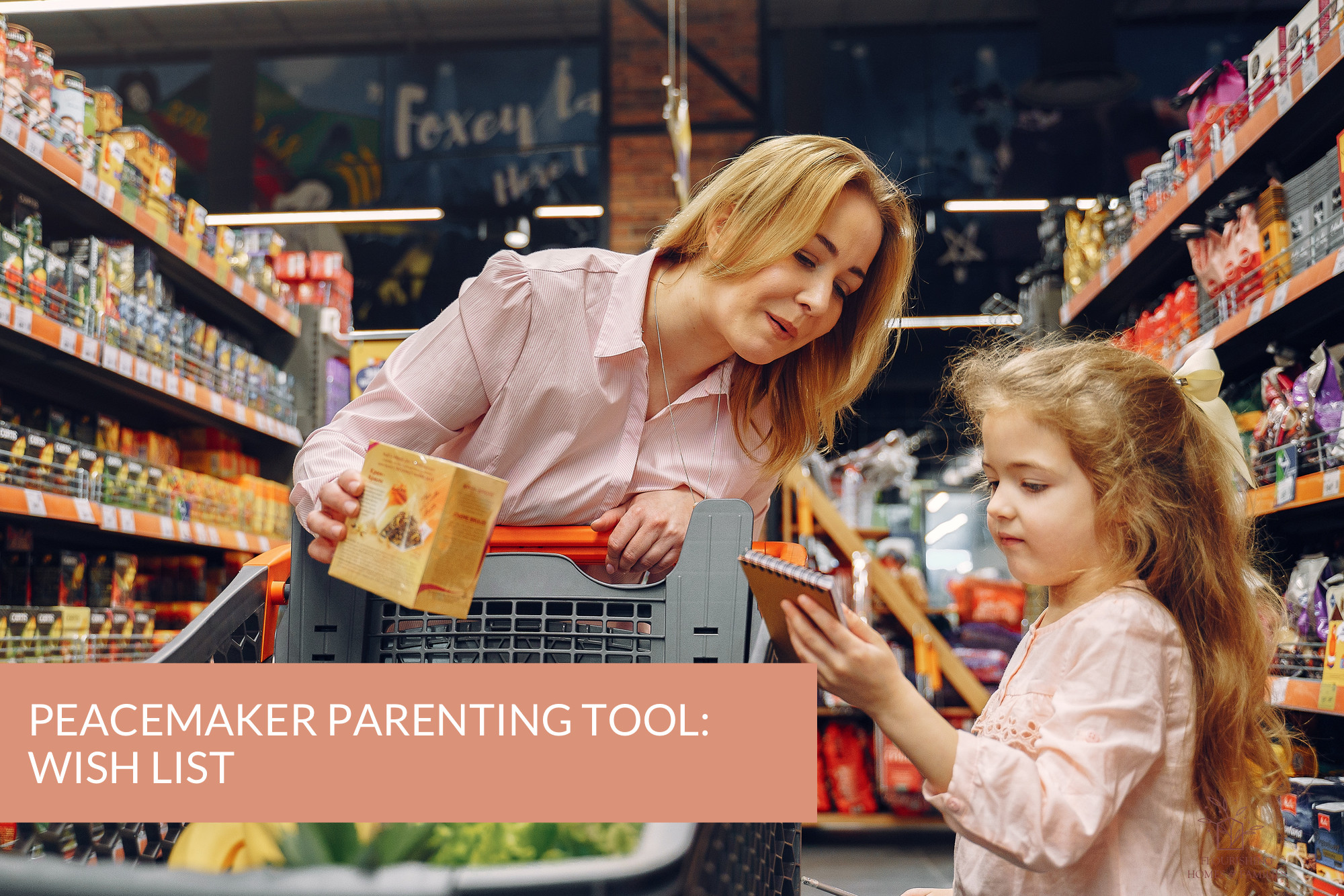
We've all experienced it! Children have strong desires and wishes and are usually very efficient and assertive in communicating them! They also have one-track minds. When they see a toy at the store they are really not able to make a mental list of all the toys they have back home. Especially once their emotions start to take over. They have limited impulse control and they will find it hard to think about something else. This is all normal. Just because they want the toy or treasure they see right now doesn't mean they are not thankful for the whole room full of toys they have at home.
BIBLICAL COMPASSION
"Keep on asking, and you will receive what you ask for. Keep on seeking, and you will find. Keep on knocking, and the door will be opened to you. For everyone who asks receives. Everyone who seeks, finds." - Matthew 7:7-8
As parents, we can learn from our child's persistent and hopeful requests from us - it's how Jesus invites us to come to Him! That doesn't mean we can or should give in to every request immediately, but we can cultivate soft and gentle hearts towards our children.
A LITTLE PERSPECTIVE
It's no coincidence that the store checkout has shiny, colorful child-sized items right at their eye level. It's a marketing strategy that no doubt has put money in someone's pocket, and taken money out of the poor parents' pocketbook! Of course we can't indulge our child every time our little ones want a prize or a treasure, but it is helpful to learn that "I want a new prize/treasure/toy" might really mean "I'm craving something tangible that tells me in my own language that you love me.
PREP BEFOREHAND
Before you take them into the store, let your little one know the plan ahead of time. "We're going to the store, and we have plenty of time to look and shop, but we are not buying any new toys today. If you see something you want, we can put it on your wish list!" Note: In order to cultivate trust, you do actually have to shop off their wish list! If you don't, they will pick up on this trick as simply dismissing their wishes, and will push back against adding things to their wish list.
KEEP A WISH LIST
Keep a pocket notebook in your bag, or make a list on your phone's Notes app. Label the list with your child's name, and let them see that the list is real. When they see a toy or treasure they really want, offer to add it to their list. (This is an example of turning a "no" into a "yes".) "I can tell you really want that Lego set! I'II be happy to put that on your wish list. Do you want to put it on a Christmas wish list or on a list to remind you when you have spending money with you?" Remember to reference the list when it IS time to get a new toy!
TAKE A PICTURE
Some kids are visual, and they like the visual reminder more than a written list. You can make an album on your phone to keep the photos in and offer to let your little ones review the pictorial wish list when they have spending money. If you have an iPhone, you can also add photos to your list in Notes, and then delete the photo from your photo album.
ONE THING TO CONSIDER
Something to keep in mind is that there's a good chance that a child who is notoriously prone to "gimmies" or really struggles with adding to a wish list instead of purchasing, may have a love language of gifts. Pray for wisdom to know when and how to show them love in the way God designed them.
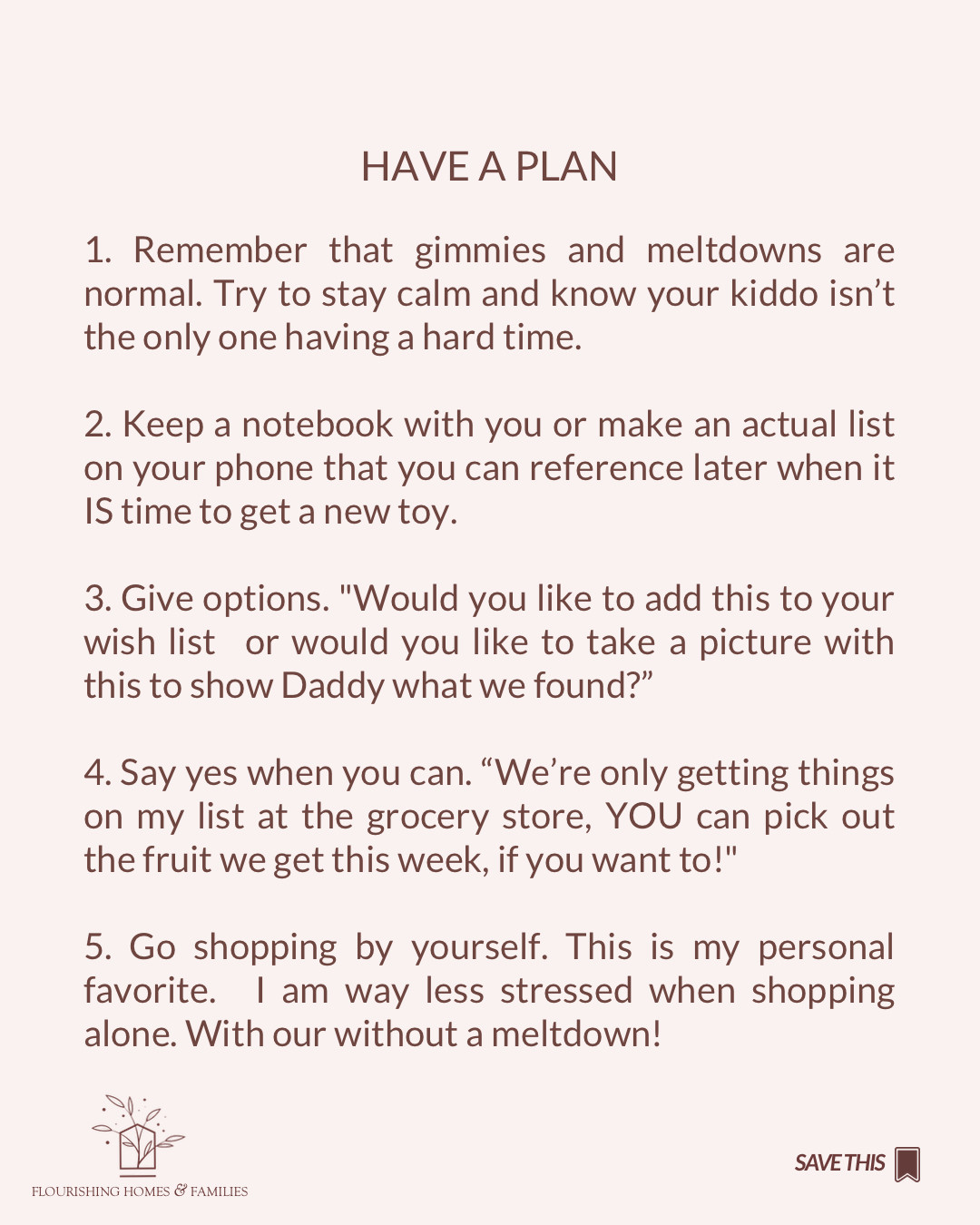
Want to learn more about Peacemaker Parenting? Our 1 hour workshop is an introduction to the core principles and foundations of Peacemaker Parenting and is full of practical tools and strategies for leading your family with peace and grace:
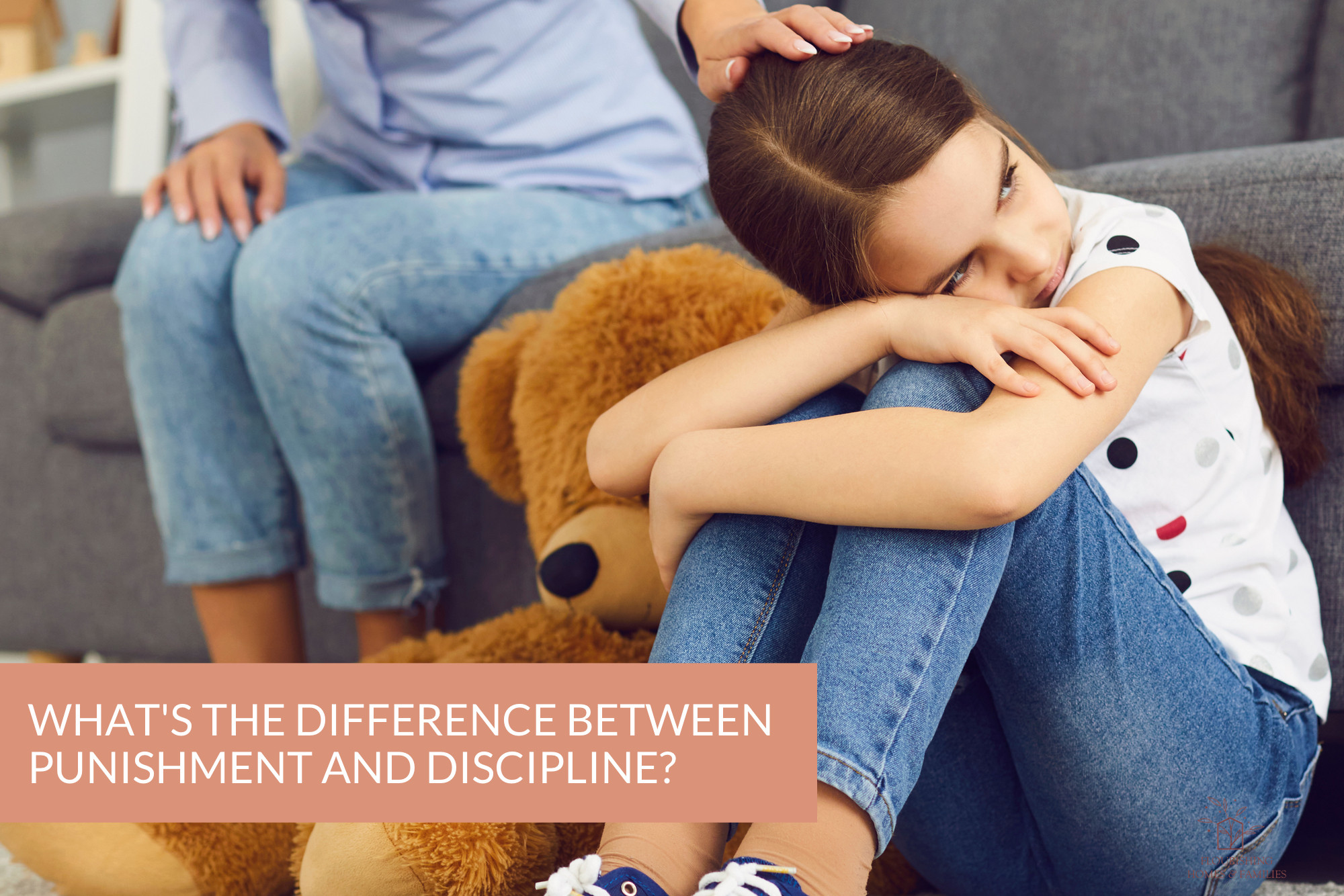
One of the biggest mindset shifts we had to make when we first started on a new parenting journey was that discipline and punishment are fundamentally different and they serve different purposes.
Punishment is retributive. It is intentionally inflicts pain. It is fear-based and it focuses on the past. Discipline is restorative. It infuses love. It is trust-based and focuses on empowering children for the future.
Parenting from a posture of peace means that our discipline is rooted in peace. Do our children always love it? No. Discipline isn’t necessarily enjoyable. But it also isn’t intentionally painful. But when it comes to discipline, parenting as a peacemaker takes a proactive and restorative approach. It aims to empower, equip, and encourage children to learn to do the right thing because it is the right thing, not because they are scared of the consequences.
A child doing the right thing because they are afraid of getting hurt (emotionally or physically) is not the same thing as a child doing the right thing because they understand another's perspective and genuinely want to do the right thing.
Proactive and restorative discipline requires parents to set their eye on the long term goal of cultivating within a child intrinsic motivation to act with charity, generosity, compassion, courage, kindness, and empathy because it is the right thing to do. And yes, that's hard sometimes! But keeping your eye on the goal, not what's in front of you right now, will help you stay focused and committed to proactive discipline.
WHAT IS DIFFERENCE BETWEEN PUNISHMENT AND DISCIPLINE?
Understanding how punishment and discipline are different can help you respond to your child's misbehavior or behavior challenges with grace and gentleness. Keeping discipline, rather than punishment, as the goal, will empower you to come up with a future-focused approach, rather than a past-focused approach.
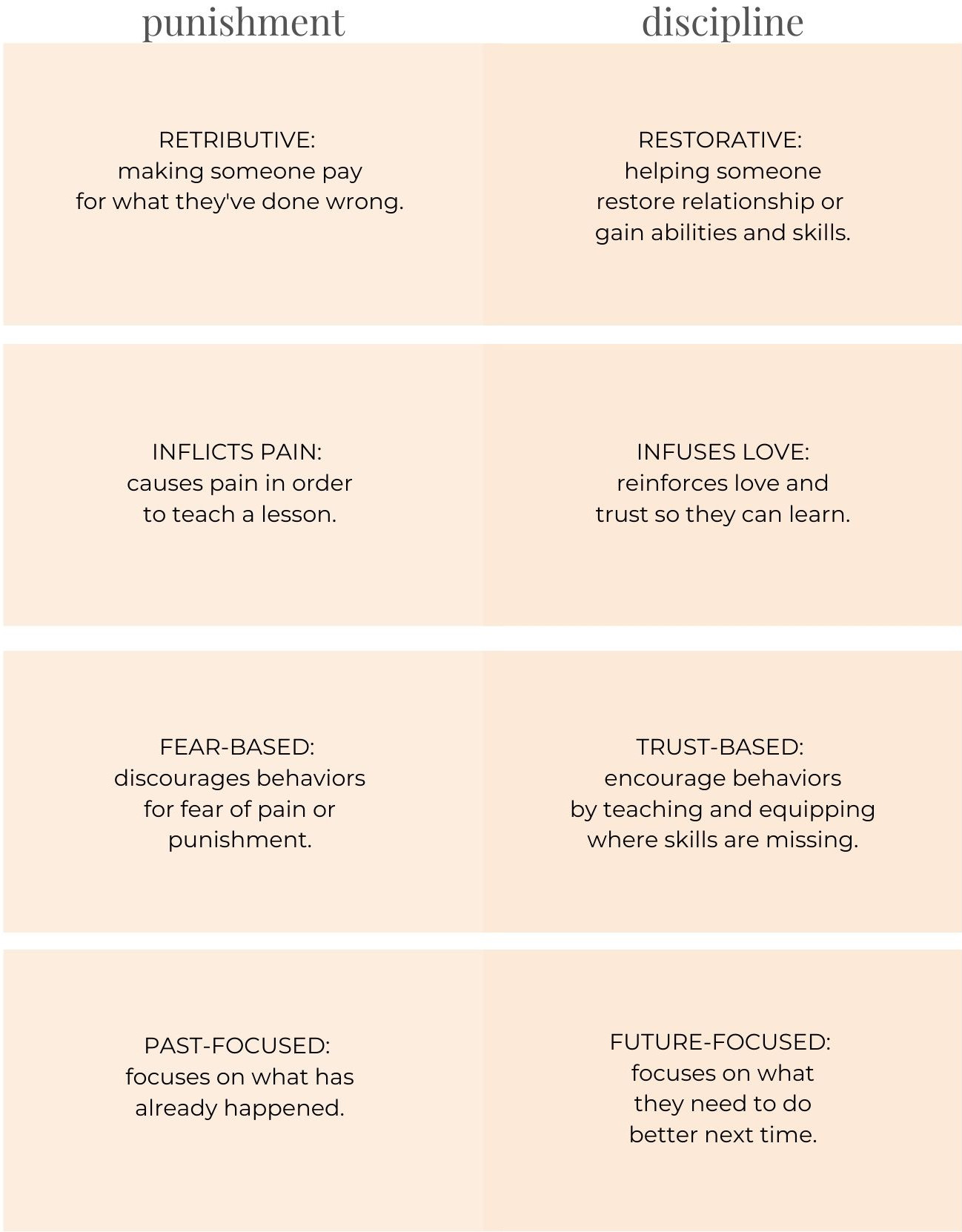

IS THERE A DIFFERENCE BETWEEN PUNISHMENT AND DISCIPLINE IN THE BIBLE?
There's no way around it: punishment and discipline both exist in Scripture. Throughout the Biblical narrative we find divine judgment and punishment, as well as wisdom-based discipline, and everything in between.
Looking at the big picture Bible is telling, with particular individuals, the nation of Israel, and His church, a pattern begins to emerge. God does not bring negative consequences into every situation in the same way. Instead there are, broadly speaking, two ways that God enacts these consequences on humans in His creation:
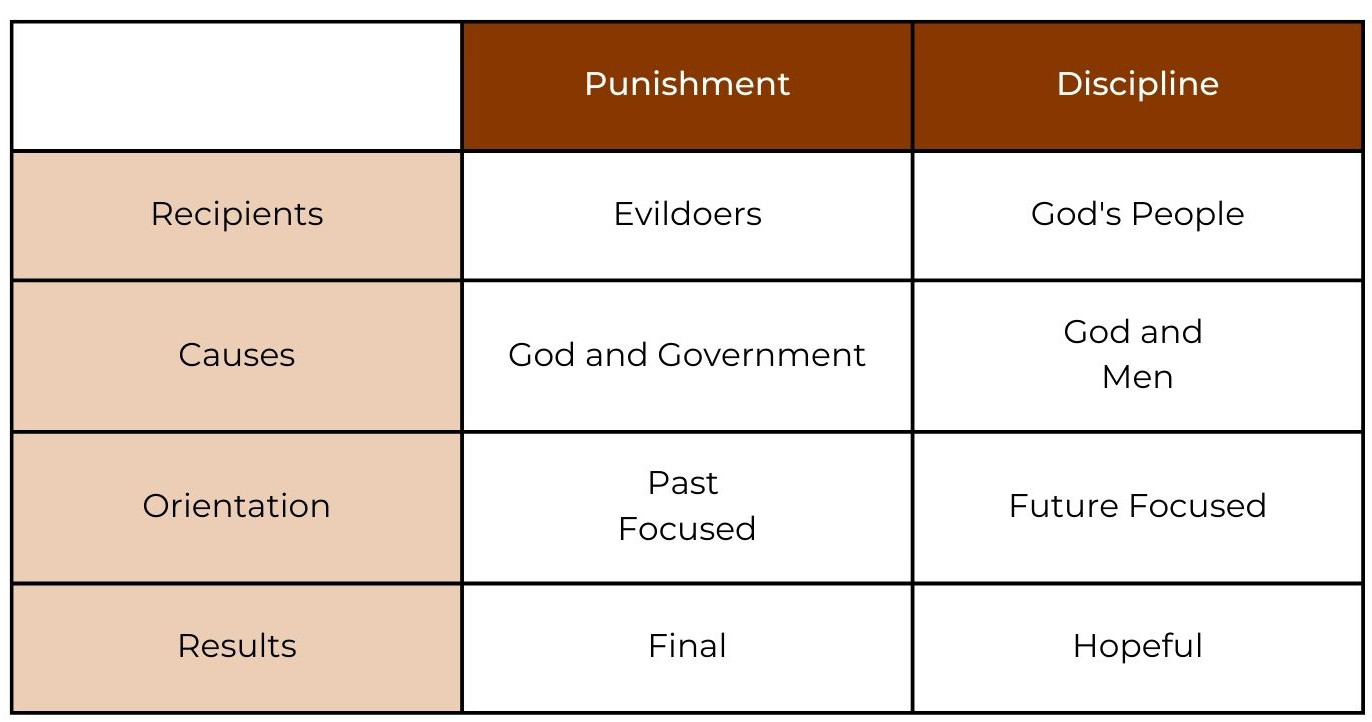
This pattern emerges from how the Bible is speaking about and describing various events. It is not drawn from the Bible’s precise and consistent use of the words “punishment” and “discipline” as terms with highly specialized meanings. So the use of particular vocabulary is not the only determiner of how a passage fits into this pattern. Instead the context and the content of each passage will help us understand what it is describing and how it fits within the pattern.
In Peacemaker Parenting, we draw distinctions between discipline and punishment. This is a mental framing device that helps us orient our positive encouragement and negative correction towards the future benefit of our child. So while we would encourage natural consequences as a regular feature of our children’s lives and logical consequences as a useful disciplinary tool that should be deployed judiciously, we would dissent from illogical and punitive consequences as a helpful form of discipline.
To be clear, the Bible will not neatly follow modern ideas about parenting in its vocabulary choices. That’s perfectly fine. We’re not trying to impose a 21st century framework onto an ancient text. We’re trying to grasp how these concepts were understood in the Bible and then apply those insights wisdom, and Jesus' kingdom ethic to our parenting today.
Want to learn more? Our Punishment and Discipline in the Bible Workshop is a deep dive on this topic!
You might also like:




